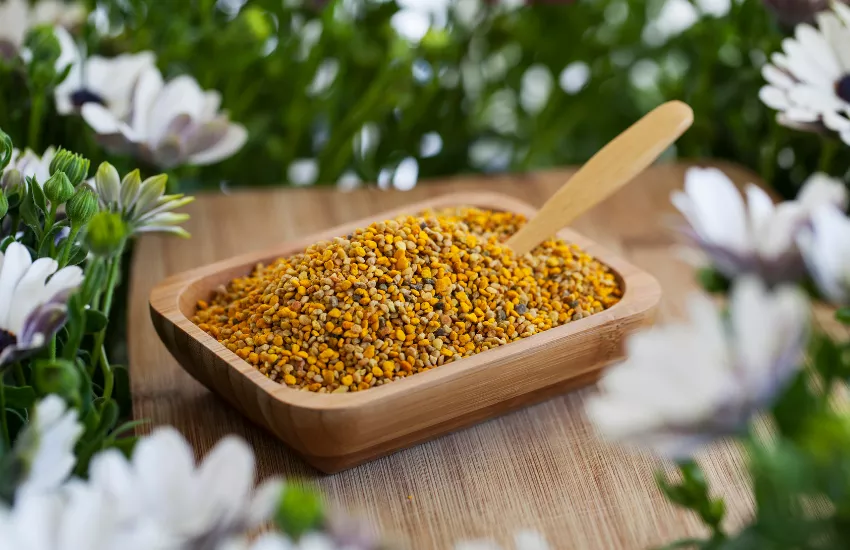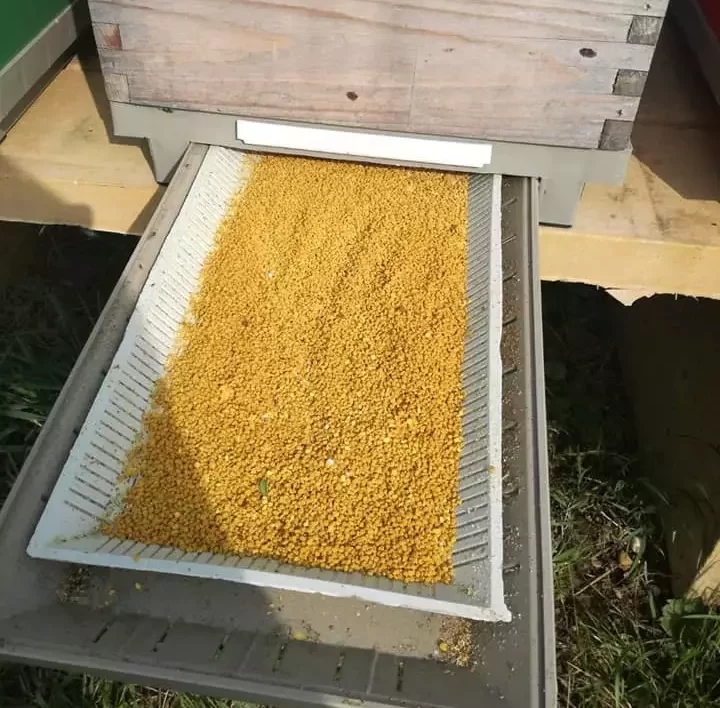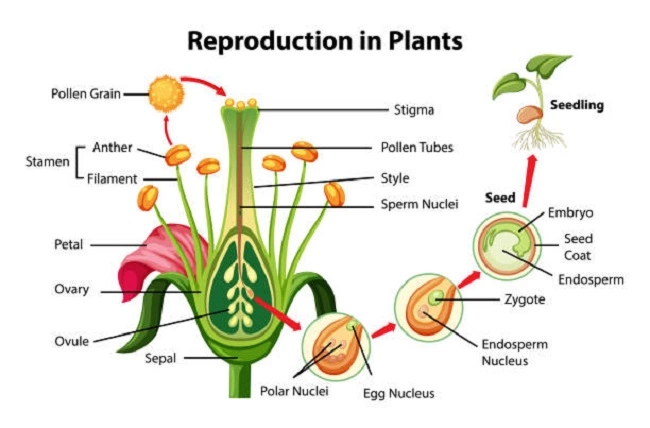All products of small hard-working bee are more than excellent for human health. One of their products I want to write to you about today is bee pollen. You can hear and read that bee pollen is one of the most complete foods on the planet when it comes to nutrients.
In this article, I will answer the questions that I have been interested earlier and which now, as a beekeeper, I get asked by the people who want to know more about beekeeping, bees and their products: what is pollen, what do bees do with pollen, what is pollen’s composition, how to use pollen, who may take pollen and of course I will list only some of its benefits for human health.

What is Bee Pollen?
Pollen or floral powder is not a bee product, but is located in the piglets of floral plants, and is used for fertilization.
Each bee instinctively collects the strongest pollen from the flowers, which is then mixed with nectar or its saliva. Bees “store” such pollen in the form of small balls and carry it on their feet. Along with the nectar, pollen is the most important bee food without which bees can’t survive, so the beekeepers also call it “bee bread.”
Pollen is one of the few natural foods, which cannot be artificially created in the laboratory because of its complexity and composition. These small granules of yellowish-orange to dark brown or black color are considered one of the healthiest foods from nature.
Depending on the type of plant from which plant pollen is collected, it can have a rough or adhesive surface. Pollen color also depends on the type of plant. The bees use it to satisfy momentary nutritional needs and it also serves as storage in the period of lack of pollen in nature.
Beekeepers collect pollen from bees by holding a thick comb at the entrance to their hives. When the bees go through the comb, pollen is collected from their legs in a collecting bucket below the hive by a knife. Bees must then come out to collect more pollen. This part can be written separately about, which I will certainly do in one of the following articles.

What Part Of The Flower Produces Pollen?
The most suitable time to collect floral powder is after the main spring grazing from June to the end of July. During this period, a large number of blooming plants provide beekeepers with larger amounts of powder than their own needs.
To give the shortest and best answer to the question which part of the flower produces pollen, I have consulted professional literature. So the answer is a little more complex because it is difficult to give a simple description. Pollen is formed only with a male flower, which is transferred from a flower to a flower with the help of wind and bees. This process takes place significantly before the opening of floral buds.
Male reproductive bodies of plants are called anthers. Anthers consist of two parts – epidermis (exotic) and sub epidermis. In the early stages of anther cell development, the sub epidermal layer cell becomes larger and is divided by tangential divisions in two layers. From the internal layer of sub epidermis, a sporogenic tissue also known as an archisporium, and is located in the central part of an anther. The archisporium will form pollen grains. From the outer layer of sub epidermis, part of the wall of the pollen bag will arise. The outer layer cells are further divided and differentiated in three different layers – endothecia, intermediate and wallpaper. These three layers surround the archisporium.
Since the pollen is a male gender station, it is the holder of the genetic properties of the plant and therefore contains all the necessary nutrients to create and develop new life.

How Do The Bees Collect Pollen?
As in many other actions, only strong and healthy bees can participate in the collection of pollen. Sick and weak societies must not work on collecting pollen due to the possibility of transfer of bee diseases either by equipment or by collected pollen.
The bees collect the flower powder because it contains proteins, fats, sugars, vitamins and other useful substances for the development of bees in the hive. And if there is not enough floral powder in the hive, the bees will be lagging in development and have lower work quality.
The collection of bee pollen is an important process, in the hive activity as well as in beekeeping, and how do the bees collect pollen, I will explain further in the text.
A bee does not have any special bags to collect pollen. The collection of pollen takes place with hairs that bees have on their feet. These hairs remove pollen from head, chest and abdomen in repeated movements. Pollen is transferred from the first pair of legs to another pair of legs; even before it is shaped into lumps on the third pair of legs, the bees glue it with saliva which contains nectar. Pollen which is shaped into the clumps on the third pair of legs is carried back to the hive. One hive can collect between 25 to 35 kg of pollen in one year. The collection of pollen is most intense between 9 and 11 am in the morning.
It is known that there are plants that secret pollen more intensively, therefore if beekeeping is performed in the area where there are no such plants; we must move the bees to a better pollen grazing location. But if we still plan longer pollen collection, the best thing is to plant plants which give good pollen grazing near the beehives.
It is desirable that the pollen grazing be as various as possible, as customers prefer pollen that is different in color to monochrome pollen. If during the year we have different uniform pollen grazing, we can eventually mix pollen and get colorful pollen, which has a better demand in the market.
What Is The Composition Of Pollen?
Many people are familiar with nutritional and medicinal properties of honey, but a small number of people know how nutritious and healthy pollen is.
Based on the nutritional composition of pollen, it can be said that it is one of the most complete foods that man uses.
And what is pollen composed of? Pollen has about 250 substances in its composition. Pollen contains: proteins (8 to 30%), amino acids, sugars that do not have a reduction effect (8.5 to 40%), starch (5 to 7%), mineral salts (2.5 to 38%), vitamins A, D, E, B1, B2, B6, C, macro elements: potassium, magnesium, calcium, iron, silicon, phosphorus, hormones, fats, fragrant matter and water.
Bee pollen contains more proteins than any food of animal origin, such as meat, eggs or milk.
It is best for the bees to have access to pollen originating from different plant species. If the bee societies are forced to use pollen from monocultures, then that lack must be compensated with mineral-vitamin supplements.
Due to so many nutrients that floral powder has in itself, it is not surprising that it is inexhaustible source of health.
Collecting And Saving Or Storage Of Pollen
The main purpose of keeping pollen is to keep and preserve the nutritional value, which will later be used for bee or human diet. After collecting the pollen, we must inspect and remove larger impurities, then package it into appropriately and put in the freezer at -18C for a minimum of 48 hours.
Pollen can be stored in the freezer for up to a year. After 48 hours of freezing, we can use pollen as fresh pollen or we can dry it. Pollen contains a significant amount of water (30-40%), and therefore, it is ideal for the development of mold and wax moth. Due to these facts, the collected pollen is required to dry. It can be simply dried in the air, as a person would dry medicinal herbs, or in the modified dryers.
Drying of pollen in the dryer is faster and safer. In the dryer, the pollen is spread in a thick, 1 cm layer, and the circulation of warm air promotes the release of moisture from pollen. During the first hour of drying, it is necessary to achieve a temperature of 49 C, in order to destroy the spores of the fungi, and then dry at 35-36 C 24-48 hours after that.
Adherence to these temperatures is essential because some amino acids are sensitive to high temperatures and can therefore change into toxic substances. Drying in the dryers in this way ends in a maximum of 48 hours. During drying, pollen loses a large part of its original mass (up to 15%), and drying is carried out until the humidity of the pollen ranging from 5 to 8% is achieved.
How To Use Bee Pollen?
Has it ever occurred to you to add bee pollen to food? It hasn’t? Don’t hesitate, feel free to do so, you won’t regret it. On the contrary, you will do a lot for your health.
Learn below how to use pollen in the correct way. The beneficial experiences say that a large number of people do not use pollen in the prescribed manner.
For example, some will take the teaspoon of pollen, chew it and swallow it. Some will mix a teaspoon of pollen in water, sweeten a little and drink it. The third will grind pollen into dust and will immediately eat it.
Why is this consumption considered wrong? Well, because grains of pollen can’t be digested. Namely, the celluloid membrane, which encases the pollen grain, cannot be decomposed and the grains only slide through without body taking advantage of at least one nutrient.
In order to have any benefits from the floral powder, it is important to soak it so the membrane can swell and burst.
If you are able, purchase and use raw pollen. In the drying process, about 20% of pollen value is lost. After drying, the rest of the pollen value is lost linearly in time. After 6 months, such pollen has lost about half of its value, so it is not smart to acquire it at the same price.
The advice is to procure dried pollen after January exclusively; if you are convinced it was kept in the freezer after drying, or kept in raw condition and dried after it was removed from the freezer.
When using pollen, make sure that:
- Raw pollen – is kept in the freezer immediately after cleaning,
- Dried pollen – is immediately placed in the freezer after drying,
- Dried pollen – in the period from the beginning of the season until the New Year.
Here are a few ways to prepare and consume pollen:
- Mix a teaspoon of pollen with lukewarm water and leave it to stand overnight. After that, you can sweeten the potion, stir and drink.
- Dissolve a teaspoon of pollen in milk acids (yogurt, milk, acidophilic milk, kefir …), because lactic acid is better degrading celluloid objects than water is.
- Combine pollen with honey in a ratio 3: 1 (honey: pollen). Leave mixture away for 10 days because the membrane, as well as in the case of water, must be soaked. In order for pollen to be degraded better, add a couple of drops of lemon juice.
- Mix bee pollen with vitamin C (lemon tea, lemonade, orange
There are no strictly defined daily doses of pollen, but recommendations are:
- 1-2 teaspoons for children per day (mix pollen into fruit juice or fruit yogurt),
- 1-2 teaspoons per day for adults,
- up to 4 soupspoons for the ill people per day.
Bee Pollen Benefits
How special bee pollen really is, it was noted by the famous ancient Greek mathematician and philosopher, Pythagoras, ancient doctor Hippocrates and the Roman writer Pliny the Older who all recommended this natural medicine for a wide use.
However, its values and benefits don’t stop there.
Due to the large number of nutrients that pollen is composed of, it is not surprising that it is an inexhaustible source of health.
Here are some of the most famous welfare of floral powder:
Pollen contains a large amount of proteins and amino acids that the organism can easily use, even if the enzymes used to decompose protein (proteinase) are not present.
Pollen improves metabolism because it is very rich in easy-to-use amino acids. In addition, pollen contributes to increasing muscle mass by renewing proteins that are spent.
Pollen reduces inflammation because it is rich in flavonoids, such as a quercetin, which have anti-inflammatory properties. Research has shown that bee pollen can reduce inflammation similar to conventional anti-inflammatory drugs.
Restores the body after serious surgeries, diseases, injuries by feeding body with vital elements, especially iron, which normalizes the level of hemoglobin in the body. In addition, by combining the use of bee pollen with mother milk, it also accelerates tissue renovation process.
Pollen can alleviate some allergies – researchers have noticed that pollen can reduce the amount of histamine which is secreted by mastocytes (cells containing histamine) as a result of an allergic reaction.
Pollen eliminates harmful bacteria because it contains a natural antibiotic element that effectively acts against salmonella and some other bacterial strains.
Pollen improves skin condition due to large amounts of antioxidants which can neutralize free radicals which cause skin exposure to sunbeam or toxins from the environment.
Pollen has anticancer properties, as shown by recent studies. Pollen significantly inhibits tumor growth and destroys malignant cells.
Pollen strengthens immunity and defends the body from colds – it has been scientifically proven that some nutrients in pollen, such as proteins, vitamins, calcium, magnesium and lecithin strengthen the defense system.
Pollen regulates digestion – affordably acts with chronic congestion issues, but also in consistent diarrhea that accompanies the inflammation of the colon.
Pollen has a positive impact on sexual health – owing to herbal substances, pollen affects the secretion of sexual glands in men (increases potency and the sperm count) and has shown increased estrogen activities in women (alleviates premenstrual problems, relieves menstrual pain and menopausal difficulties).
Pollen helps with prostate difficulties – through many studies, it has been proven that pollen also contains a component soluble in fat that combats inflammation and stops a frequent need to urinate significantly during the prostate treatment.
Who Must Not Consume Pollen?
Pollen is generally considered safe for use; as frequent or more dangerous side effects have not been recorded. Pollen is natural and non-toxic. Precautions and consulting a doctor are recommended for:
- diabetics,
- people with chronic illnesses,
- people who currently take some medications,
- pregnant women and breast feeders.
The side effect that most often manifests is an allergic reaction. People who are otherwise allergic should take pollen with caution. It is recommended to take it in smaller amounts over a few days and keep notice of possible symptoms. If you notice the symptoms of allergies, stop consuming pollen.
It is recommended to consume freshly frozen pollen and pollen that comes in different colors, which means that it originated from different plants. This will keep the diversity of ingredients, and if the pollen is frozen abruptly while fresh, all sensitive ingredients will be saved.